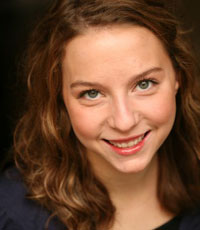“Whew . . . A Day Off!”: A.C.T. Master of Fine Arts Program Students Take Their Craft to a Local High School
 |
| Rebekah Brockman, A.C.T. Master of Fine Arts Program class of 2013 |
Connecting their own work to the RASOTA theater students’ theme of “Legacy: Fame v. Infamy,” the A.C.T. M.F.A. Program actors presented self-selected scenes from Arthur Miller’s Crucible, William Shakespeare’s Henry IV, Part I, and Thieves, a youthful adaptation of Shakespeare’s Henry IV plays created last year by A.C.T. graduate Matt Bradley. The scene work was followed by a candid student-to-student Q&A about the challenges of forging a career in professional theater, facilitated by Stauter.
Afterwards, M.F.A. Program student Rebekah Brockman—who, like her classmates, was at the time juggling multiple roles, performing in a Conservatory production while understudying A.C.T.’s mainstage production of Elektra and keeping up with her own classwork—reflected on what this transgenerational experience means for her own developing sense of herself as an artist.
“It is my only day to sleep in!”
“That is the only time I have to memorize lines.”
“It isn’t just working on the day off, it is rehearsing in the limited time I have leading up to the day off.”
“Ummm . . . my dog died?”
“What do I get if I do it?”
I’m not going to lie. These are all things that went through our heads as A.C.T. M.F.A. Program students when Elizabeth asked us to volunteer our time on the one day we had off, in the midst of another week in A.C.T.’s rigorous training program. However, I would like to address the ultimate question: “What do I get if I do it?”
 |
| RASOTA students react to the workshop. |
I don’t think I understood what it truly meant to be a part of an artistic community until I came to American Conservatory Theater. Now entering my third year of the M.F.A. Program, I find myself with a deeper understanding of what it means to invest in mycommunity. Through the education outreach programs that Elizabeth has created, we M.F.A. Program students have unparalleled opportunities to work with emerging young artists. Workshops like the one we did at Ruth Asawa School of the Arts remind me and my classmates just how important it is to cultivate a younger generation of artists’ interest in theater. The reality is that some students at RASOTA may not end up pursuing careers in the arts, but their time in such an arts-focused environment means they are learning an appreciation for the craft, developing a commitment to hard work, discovering talents and interests, and fostering the type of dedication it takes to succeed in whatever field they do eventually choose to pursue.
 |
| Tyee J. Tilghman, A.C.T. Master of Fine Arts Program class of 2013, interacts with the RASOTA students. |
I am grateful that I pushed my excuses aside and seized an opportunity; in return, I experienced a revitalization of the work I sometimes take for granted when I am doing it every day. It was a surprising reminder from eager young artists, and I take pride in being involved in a training program—and a theater—that invests in the education of multiple generations of artists, to preserve culture in the community.

